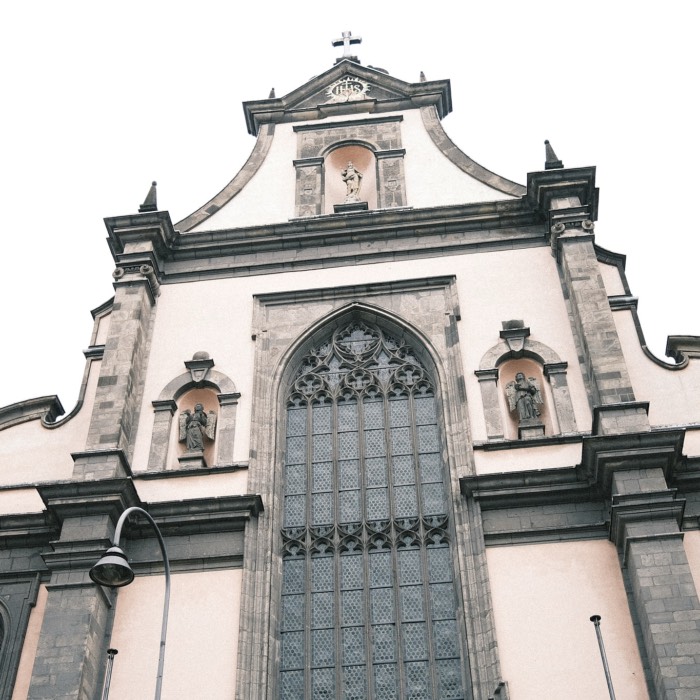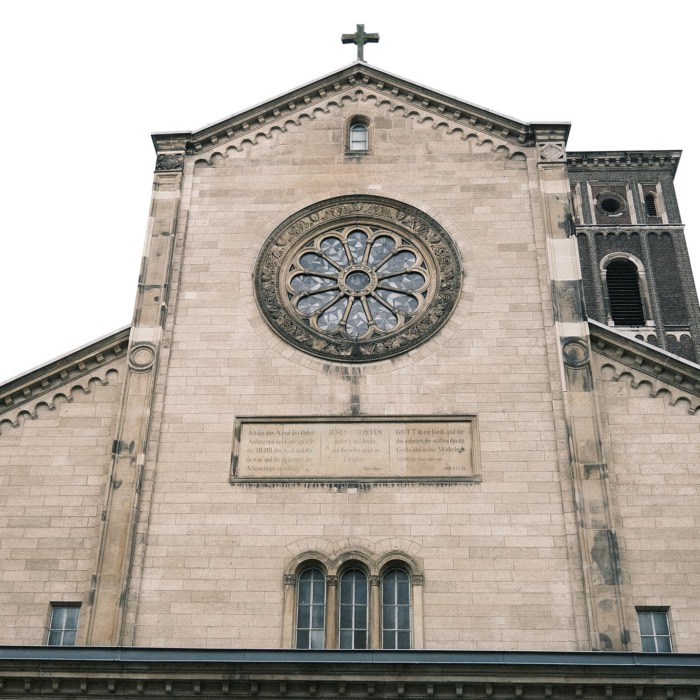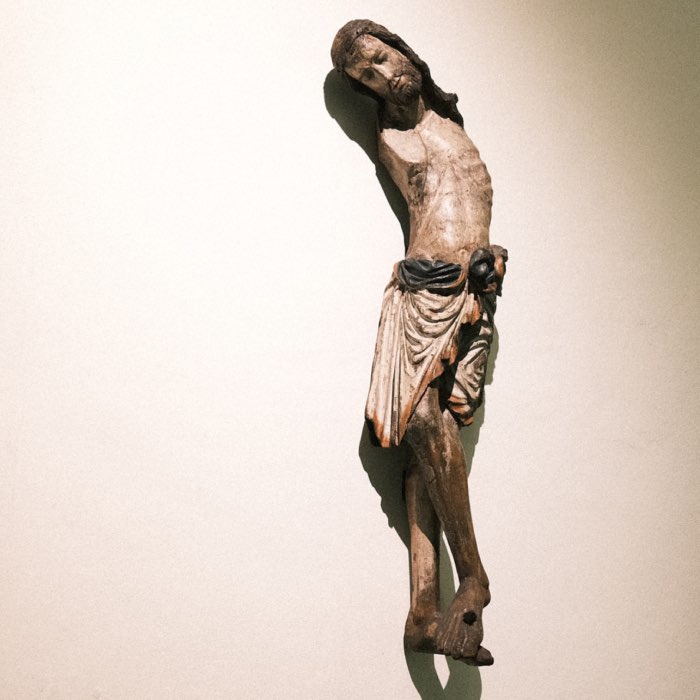Antoniterkirche in Cologne: Transformation of a medieval church throughout history
The Antoniterkirche is one of the key Protestant churches in Cologne, standing out as a unique Gothic structure amidst the city’s predominantly Catholic heritage. Located on Schildergasse, a bustling shopping street, the Antoniterkirche provides a quiet retreat for visitors, combining historical architecture with modern spiritual significance. Originally built by the Catholic Antonite Order in the 14th century, the church has undergone several transformations, most notably during the Reformation and the aftermath of World War II, reflecting Cologne’s dynamic religious and cultural history.
Founding and medieval origins
The Antoniterkirche was founded by the Antonite Order (Antoniterorden), a medieval religious order dedicated to caring for people suffering from ergotism, also known as ‘St. Anthony’s Fire’. Construction of the church began in 1350 and was completed between 1370 and 1378. It was built in the Gothic style typical of the period, characterized by its three-aisled basilica structure with rib-vaulted ceilings. The church’s design also reflected elements of mendicant orders, such as the lack of a tower, replaced instead by a modest roof turret (Dachreiter), and its simple yet graceful architecture suited the Antonite Order’s focus on humility and care.
The church features a polygonal main choir at its eastern end and a smaller, separate choir in the northern aisle. These Gothic elements, including the pointed arches and ribbed vaults, provide an architectural continuity with other major churches built in Cologne during the same period. The church was originally part of a larger Antonite complex, including a hospital and monastery, which played a significant role in providing medical care in medieval Cologne.
 Cast relief on the entrance door.
Cast relief on the entrance door.
Secularization and conversion to protestant use
The French occupation of Cologne in 1794 brought significant changes to the city’s religious institutions. Following the secularization decrees of the Napoleonic era in 1802, the Antonite monastery was dissolved, and many of the city’s Catholic monastic churches were repurposed. With the newfound religious freedom granted by the French, Cologne’s Protestant community, which had long been forced to hold services secretly or outside the city in places like Mülheim or Frechen, was finally able to worship openly. On August 6, 1802, the Antoniterkirche was handed over to the Protestant community, making it one of the first Protestant churches in Cologne.
The church underwent significant modifications between 1802 and 1805 under the guidance of Ferdinand Franz Wallraf to adapt it for Protestant worship. Several Gothic pillars were removed to open up the space, galleries were added to the aisles and the west, and a pulpit-altar (Kanzelaltar) was installed, which allowed for a more sermon-centric layout typical of Protestant churches. The renovation expanded the church’s capacity to hold around 800 people, transforming it into an important center for Protestant worship in Cologne.
Late 19th century changes
By the end of the 19th century, the Antoniterkirche had become somewhat outdated and cramped compared to the newer, more grandiose Protestant churches like the Trinitatiskirche. As part of a restoration project focused on preserving the church’s historical character, the side galleries and the pulpit-altar, which blocked the view of the Gothic choir, were removed. This renovation restored some of the church’s original Gothic elegance and allowed for a better appreciation of its medieval architecture.
World War II destruction and post-war reconstruction
The Antoniterkirche, like many of Cologne’s historic buildings, was heavily damaged during World War II. The most significant destruction occurred on May 31, 1942, during an air raid that left the church largely in ruins. Reconstruction efforts began in 1946, led by architect Georg Eberlein, who used Ferdinand Franz Wallraf’s earlier designs as a guide. The church was rebuilt using as much of the original structure as possible, including a new west entrance and organ loft. By May 1952, the church was restored enough to hold its first post-war service, with Federal President Theodor Heuss in attendance for the re-consecration ceremony. In 1954, the church’s roof turret was rebuilt, and further renovations, including a new west facade due to the construction of the nearby North-South urban highway, were completed between 1961 and 1964.
Throughout the second half of the 20th century, additional efforts were made to restore the church to its historical appearance. In 1979-1980, the church’s interior was repainted in colors reminiscent of its original medieval design. Further structural repairs were undertaken in the 1990s, and the church continues to be maintained and preserved, with significant restorations in 2011, focusing on lighting, electrical systems, and structural updates to keep the building safe and functional.
Modern role and significance
Today, the Antoniterkirche plays a dual role as both a place of worship and a cultural monument. Its historical significance as one of the earliest Protestant churches in Cologne, combined with its Gothic architectural heritage, makes it a site of interest for both religious and secular visitors. The church hosts regular services for Cologne’s Protestant community and serves as a venue for concerts, lectures, and other cultural events. Its prominent location on Schildergasse, one of the busiest shopping streets in Cologne, allows it to act as a peaceful retreat for visitors amidst the city’s bustling atmosphere.
One of the most notable modern additions to the church is Ernst Barlach’s ‘The Floating One’ (Der Schwebende), a striking anti-war memorial sculpture installed in the church in 1952. This artwork, originally created as a memorial to the victims of World War I, has since come to symbolize remembrance for the tragedies of both World Wars, making it a powerful element of the church’s interior.
 Romanesque baptismal font and ‘Crucifix II’ by Ernst Barlach.
Romanesque baptismal font and ‘Crucifix II’ by Ernst Barlach.
 Kruzifix II by Ernst Barlach, 1918.
Kruzifix II by Ernst Barlach, 1918.
 Romanesque baptismal font. The Antonite church originally had no baptismal font, as it was a mendicant church and did not have the baptismal rights of a parish church. This only changed when it became a Protestant parish church. The Romanesque baptismal font now installed in the south aisle is a 12th-century work from the Lower Rhine-Maasland made of Naumur bluestone. There are four corner heads on the sides depicting mythical creatures. The baptismal font was made available to the Protestant congregation by the Schnütgen Museum from its holdings. Its original origin is not exactly clear.
Romanesque baptismal font. The Antonite church originally had no baptismal font, as it was a mendicant church and did not have the baptismal rights of a parish church. This only changed when it became a Protestant parish church. The Romanesque baptismal font now installed in the south aisle is a 12th-century work from the Lower Rhine-Maasland made of Naumur bluestone. There are four corner heads on the sides depicting mythical creatures. The baptismal font was made available to the Protestant congregation by the Schnütgen Museum from its holdings. Its original origin is not exactly clear.
 Lid of the Romanesque baptismal font, decorated with the mono-gram ‘Alpha and Omega’.
Lid of the Romanesque baptismal font, decorated with the mono-gram ‘Alpha and Omega’.
 Alpha and Omega candle in the corner of the baptismal font.
Alpha and Omega candle in the corner of the baptismal font.

 ‘Der Schwebende’ (‘The Floatin One’) by Ernst Barlach. This is a second casting of the sculpture from 1927, the original of which was melted down in Güstrow Cathedral by the National Socialists as “degenerate art”. In 1952, for the rededication of the Antonite church, the sculpture was hung in the church and a third cast was returned to the Güstrow cathedral parish in 1953. The figure bears the facial features of the artist Käthe Kollwitz. The figure hangs above a stone slab with the dates of the First World War and the years of National Socialist rule from 1933 to 1945.
‘Der Schwebende’ (‘The Floatin One’) by Ernst Barlach. This is a second casting of the sculpture from 1927, the original of which was melted down in Güstrow Cathedral by the National Socialists as “degenerate art”. In 1952, for the rededication of the Antonite church, the sculpture was hung in the church and a third cast was returned to the Güstrow cathedral parish in 1953. The figure bears the facial features of the artist Käthe Kollwitz. The figure hangs above a stone slab with the dates of the First World War and the years of National Socialist rule from 1933 to 1945.
 The Teaching Christ, another sculpture by Ernst Barlach, Bronze sculpture, 1931/1938/1950.
The Teaching Christ, another sculpture by Ernst Barlach, Bronze sculpture, 1931/1938/1950.
 Coventry cross of nails in the northern side chapel. The replica of three nails from the former Coventry Cross is symbolically regarded as the ‘Cross of Nails of Coventry’ and is presented to communities of the Cross of Nails - and thus to communities that work intensively for peace and reconciliation.
Coventry cross of nails in the northern side chapel. The replica of three nails from the former Coventry Cross is symbolically regarded as the ‘Cross of Nails of Coventry’ and is presented to communities of the Cross of Nails - and thus to communities that work intensively for peace and reconciliation.
 Cast sculpture of a nativity scene. The inscription reads: ‘Fear not. Behold, I proclaim great joy to you’.
Cast sculpture of a nativity scene. The inscription reads: ‘Fear not. Behold, I proclaim great joy to you’.
 Cast sculpture of a nativity scene. The inscription reads: ‘Fear not. Behold, I proclaim great joy to you’.
Cast sculpture of a nativity scene. The inscription reads: ‘Fear not. Behold, I proclaim great joy to you’.
Conclusion
The Antoniterkirche reflects Cologne’s complex religious history, transitioning from its medieval origins as a Catholic church serving the Antonite Order to its role as one of the first Protestant churches in the city. Despite the destruction it faced during World War II, the church has been carefully restored, blending historical Gothic architecture with modern artistic and cultural elements. Today, the Antoniterkirche continues to be a significant religious and cultural hub, offering a space for reflection and community in the heart of Cologne. Its presence on Schildergasse ensures that it remains an integral part of the city’s historical and spiritual landscape.
 The church is located on Schildergasse, one of the busiest shopping streets in Cologne.
The church is located on Schildergasse, one of the busiest shopping streets in Cologne.
If you’re visiting Cologne and you’re around the Schildergasse area, think about making a short stop at the Antoniterkirche. It’s an unique place where you can experience the city’s rich religious heritage and architectural beauty in a serene and contemplative setting, surrounded by the hustle and bustle of the city center.
References and further reading
- Wikipedia article on the Antoniterkircheꜛ
- Website of the Antoniterkircheꜛ
- Jürgen Kaiser, Florian Monheim, Die großen romanischen Kirchen in Köln, 2017, Greven Verlag, ISBN: 9783774306875
- Ulrich Krings, Otmar Schwab, Köln, die romanischen Kirchen - Zerstörung und Wiederherstellung, 2007, Bachem, ISBN: 9783761619643
- Hiltrud Kier, Die Romanischen Kirchen in Köln, 2014, Hrsg.: Förderverein Romanische Kirchen Köln e. V. 2. Auflage, ISBN: 978-3-7616-2842-3


















comments